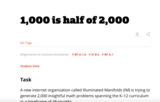
This real-life modeling task could serve as a summative exercise in which many aspects of students' knowledge of functions are put to work.
- Subject:
- Mathematics
- Material Type:
- Activity/Lab
- Provider:
- Illustrative Mathematics
- Date Added:
- 04/26/2022

These resources have been vetted by staff at the Utah State Board of Education. LEAs have the duty to select instructional materials that best correlate to the core standards for Utah public schools. (CA 53G-4-402(1(a)). Vetting of these resources by USBE staff curriculum specialists does not imply the resources have received official endorsement of the State Board. Educators are responsible to ensure use of these materials complies with LEA policies and directives.
These resources have been vetted by staff at the Utah State Board of Education.

This real-life modeling task could serve as a summative exercise in which many aspects of students' knowledge of functions are put to work.

At Tier 2, schools provide small group, standardized academic, social, emotional, and behavioral supports using validated intervention programs. Use this guide to determine if your Tier 2 program is on the right track.
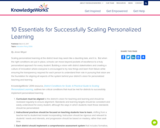
Scaling personalized learning at the district level may seem like a daunting task, and it is. But when the right conditions are put in place, schools can move beyond pockets of excellence to a truly personalized approach for every student. Building a vision with district stakeholders and creating a culture of innovation where everyone is encouraged to try new things and learn from failure while ensuring the transparency required for each person to understand their role in pursuing that vision are the foundation for aligning all aspects of the system behind your district's vision for personalized teaching and learning.
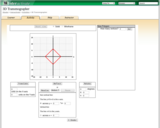
This lesson contains an applet that allows students to explore translations, reflections, and rotations.
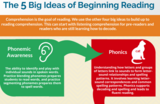
This infographic depicts the five components of effective reading instruction: phonemic awareness, phonics, fluency, vocabulary, and reading comprehension. Phonemic awareness, phonics, fluency and vocabulary all build up to reading comprehension, which is the goal of reading.

Too often math students lean on teachers to think for them, but there are some simple ways to guide them to think for themselves.

Al igual que hemos aprendido qué es la dislexia a través de la investigación empírica, también hemos llegado a comprender lo que no es. Un análisis más detallado de lo que hemos aprendido ayuda a disipar mitos y malentendidos frecuentes sobre la dislexia. A continuación, se muestran seis mitos y conceptos erróneos frecuentes sobre la dislexia, seguidos de la realidad que hemos llegado a comprender sobre ella a través de la investigación empírica.

6 Realidades de la dislexia y las necesidades de las personas con dislexia
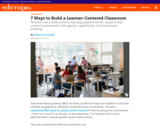
Teachers can create positive learning experiences for students that combine assessment with agency, opportunity, and community building.

The AASL Standards framework reflects a comprehensive approach to teaching and learning by demonstrating the connection between learner, librarian, and library standards. Each section of the standards framework was designed to reflect the others, ensuring that standards-related activities would be mutually reinforcing, simultaneously building capacity among learners, school librarians, and the school library. This pamphlet provides educators access specifically to AASL’s learner standards.

The AASL Standards framework reflects a comprehensive approach to teaching and learning by demonstrating the connection between learner, librarian, and library standards. Each section of the standards framework was designed to reflect the others, ensuring that standards-related activities would be mutually reinforcing, simultaneously building capacity among learners, school librarians, and the school library. This pamphlet provides educators access specifically to AASL’s librarian standards.

ACTFL’s publications elevate understanding and support for the value of language learning at all levels of instruction.
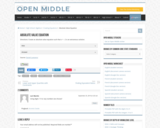
Open Middle provides math problems that have a closed beginning, a closed end, and an open middle. This means that there are multiple ways to approach and ultimately solve the problems. Open middle problems generally require a higher Depth of Knowledge than most problems that assess procedural and conceptual understanding.
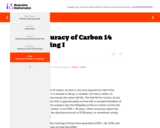
This task examines, from a mathematical and statistical point of view, how scientists measure the age of organic materials by measuring the ratio of Carbon 14 to Carbon 12. The focus here is on the statistical nature of such dating.
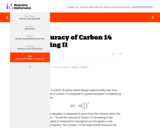
This Illustrative Mathematics task is a refinement of "Carbon 14 dating" which focuses on accuracy. While the mathematical part of this task is suitable for assessment, the context makes it more appropriate for instructional purposes. This type of question is very important in science and it also provides an opportunity to study the very subtle question of how errors behave when applying a function: in some cases the errors can be magnified while in others they are lessened.
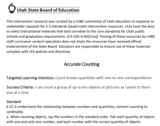
The focus of the Accurate Counting intervention is counting known quantities with one-to-one correspondence. This intervention works on counting up to ten objects or pictures that are in a straight line.
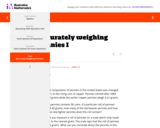
This task asks students to solve systems of linear equations exactly and approximately (e.g., with graphs), focusing on pairs of linear equations in two variables.
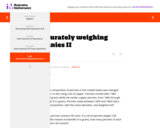
This task is a somewhat more complicated version of ''Accurately weighing pennies I'' as a third equation is needed in order to solve part (a) explicitly.

A brief guide to engaging students in narrative writing by having them program robots to act out their stories.
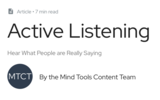
This article provides suggestions for how to improve your active listening skills -- and that you could use with your students.